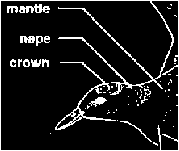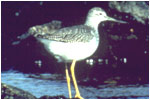| |
|
What are Shorebirds?
Morphology
 Morphology refers to what an organism physically looks like. Shape, color, and size are all examples of morphology. In his book Shorebirds of the Pacific Northwest, Dennis Paulson states, "Each shorebird is a beautifully functioning organism, the parts finely tuned by natural selection to work together to adapt the bird to its environment."
Morphology refers to what an organism physically looks like. Shape, color, and size are all examples of morphology. In his book Shorebirds of the Pacific Northwest, Dennis Paulson states, "Each shorebird is a beautifully functioning organism, the parts finely tuned by natural selection to work together to adapt the bird to its environment." 
One of the most striking physical traits of shorebirds is their stately posture. They stand up very straight on long legs. Shorebirds that wade to find food have the longest legs. They also have long pointed bills with which they probe in the mud or water for small animals to eat. Shorebirds have long pointed wings and are strong, fast fliers. There is variation among the species, but in general their size is relatively small.
The coloration of shorebirds might at first be thought of as rather ordinary. One realizes the value of their brown, banded plumage the first time one sees a beach with 10,000 legs! Their coloration is an adaptation of camouflage. Shorebirds are generally speckled brown, rusty, and white on the back. Some have white or black patches on the head, breast, or belly. They blend in well with the sandy, muddy, or grassy areas where they feed and nest. Their camouflage helps protect them from predators such as eagles, hawks, gulls, and foxes.
 Shorebirds tend to be darker colored on the back than on the belly. Have you ever seen a flying flock of brown sandpipers turn together in the air and suddenly appear white as their undersides are flashed at you? Perhaps this bicoloration is an adaptation similar to that of many fish. When observed from below, against the light, the bird is inconspicuously light-colored to a potential predator. When a flying hawk observes shorebirds from above, their darker backs blend in with the beach or mudflat. As you learn more about shorebirds and their environment, see if you think this theory makes sense. Shorebirds tend to be darker colored on the back than on the belly. Have you ever seen a flying flock of brown sandpipers turn together in the air and suddenly appear white as their undersides are flashed at you? Perhaps this bicoloration is an adaptation similar to that of many fish. When observed from below, against the light, the bird is inconspicuously light-colored to a potential predator. When a flying hawk observes shorebirds from above, their darker backs blend in with the beach or mudflat. As you learn more about shorebirds and their environment, see if you think this theory makes sense.
|
|
|
|

